Denon AVR-S770H
Product Name: Denon AVR-S770H
Product Description: 7.2 CH 8K AV Receiver
-
Design - 9/10
9/10
-
Audio Quality - 9/10
9/10
-
Inputs / Ports - 9/10
9/10
-
OS, Apps and Features - 9/10
9/10
-
Price / Quality - 9/10
9/10
Summary
Reviewed at $649.00
Pros
- Very good performance
- Plenty online & offline features
- Full 40Gbps HDMI 2.1 ports
- Affordable price
Cons
- No composite ports
- No front HDMI input
- More expensive this year
- No backlight on remote
Cheapest Places to Buy :
*We are a reader-supported website. When you buy through links on our site, we may earn a small affiliate commission at no extra cost to you. Home Media Entertainment does not accept money for reviews.*
Introduction
During the second half of 2023 Denon announced the release of two new affordable AV receivers that belong in their S-series. Recently we had the chance to check one of them. So today it was about time we check the other part of the family. And in our Denon AVR-S770H review we are going to test this affordable 7.2 channels AV receiver and determine its value.

Denon had already refreshed part of their S-series in 2022 with the AVR-S570BT and the AVR-S970H. So last year they brought the entire S-series up to date with the new AVR-S670H and AVR-S770H. But what is interesting is that the AVR-S770H we have for testing is the cheapest Dolby Atmos capable AV receiver Denon has for sale. And this will surely bring a lot of customers looking for a cheap solution for their entertainment.
But before we proceed let’s take a look at its overall specs real quick. The Denon AVR-S770H is a 7.2 channels AV receiver with 75 watts of power for each channel. It supports Dolby Atmos and DTS:X and comes with the standard feature list you will find in most these low and mid-tier Denon units.
For a price of just $649 you get the standard Dolby Atmos treatment. Which is not bad at all if you are tight on budget. And this unit seems to click all the right buttons for its category. Is it as good as it seems? Let’s find out.
Design
Looks and Dimensions
Most units in the S-series feature exactly the same chassis with the only change being in the dimensions. So there are no real surprises with the S770H. At least not this time and until Denon decides a design overhaul for the entire series.
The unit measures 17.1″ x 13.3″ x 8.5″ (434 x 339 x 215 mm) with the antennas in vertical position. As usual, you can slightly minimize its height to 6″ (151 mm) if you turn them horizontally without any loss of wireless quality.
From our measurements it seems that the AVR-S770H is using the exact same chassis as the AVR-S670H. The only change is the weight at 19.0 lbs (8.6 kg). But this is normal as this model features a couple more amplifiers for the two extra channels.

Front Layout
In real Denon fashion the outer shell is featuring straight lines and sharp corners. This is your typical black box receiver after all that performs much better than it looks. The front face features a brushed metal texture with an exact shame layout as most previous releases.
This means a big central display showing all functions. With two big circular knobs at each side for volume on the right and source selection on the left. Under the source selection knob we find the power button. While a thin line under the central display houses 10 function buttons. These are for Zone 2 and Tuner controls, Band, Mode, Dimmer and Status along with two groups of four circular buttons underneath. One group being the quick selection buttons and the other the sound modes.
Under these buttons, as usual, we get the front ports. Here we find the headphones jack and setup microphone port on the left. And a single USB port on the right that you can use to stream audio from a USB based external storage like a flash drive. There is no HDMI input in this model either as with many units lately.
Internal Hardware
Next we will take a look at the insides of the unit.
The receiver features discrete high-current amplifiers on all channels with low-impedance drive capability.
As for the DAC used in this one unfortunately we do not have specifics. But since both the AVR-S670H and the AVR-X1800H are using a 32-bit Texas Instruments PCM5102A DAC we assume that this one uses the same also.
This DAC provides low distortion and the widest possible dynamic range.

Remote
As for the remote, the one we found with the AVR-S770H is codenamed RC-1257. The remote is very similar to the RC-1258 remote the AVR-S670H is using. With the only difference being the addition of the Main and Zone 2 buttons at the top.
The remote comes with all the input buttons at the top along with the HEOS and Bluetooth functions. Navigation buttons are in the middle along with channel and volume controls. While playback, quick selection and sound mode buttons are as usual at the bottom.
The remote in general is a big one. On the other hand the buttons are relatively small and we would like them a little bigger to be easier to the touch. At least the long distance between them minimize the risk of a wrong command. Which can be a regular phenomenon in a dark environment since the remote lacks any kind of backlight functionality. Its construction is good and feels pretty solid with a nice texture on top to make it look a little bit more premium.
The changes we get in this year’s version is that Denon took out the Eco button. And they also changed the sound mode buttons at the bottom from colored ones to single white color. But that’s about it. Everything else is exactly the same.
Audio Specifications
In terms of support the AVR-S770H seems to be exactly the same as the AVR-S970H.
This means we get support for Dolby Atmos and DTS:X object oriented audio. But along with these we also get support for up-mixing and virtual technologies in order to cover all needs and specific room configurations.

Virtual Sound & Up-mixers
When it comes to up-mixing tech we find the usual Dolby Surround and DTS Neural:X. What these up-mixing tech are doing is to up-convert stereo and legacy mixes in order to make use of all the speakers you have in your setup.
As for virtual tech the Dolby Atmos Height Virtualization and DTS Virtual:X are capable of creating sounds that originate from virtual created speakers around your room where there are no physical speakers present.
These virtual technologies obviously are not as good and accurate as having real physical speakers and are very much room dependent. Also the sound many times can be heard very over-processed, something we were never very fond of.
Internal Amplification
The unit comes with 7 channels of built-in amplification. And each channel can output 75 watts of power (8 ohm, 20 Hz – 20 kHz, 0.08% 2ch drive). Keep in mind that this is only for 2 channels driven. This means that when all 7 channels are active this number goes down considerably.
It can also support up to two subwoofers which is the standard nowadays. But surely not the best as many new units can support up to 4 subwoofers now. But two is more than enough for such an affordable unit that you are mostly going to use in basic setups.
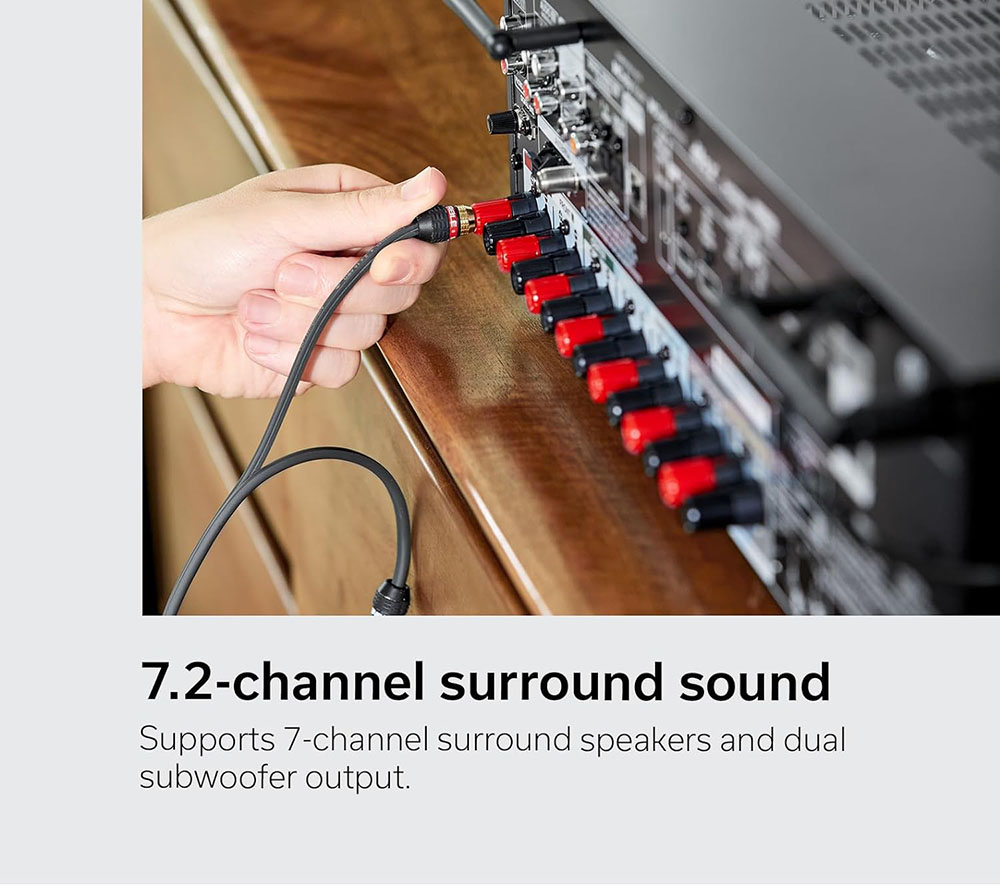
Movies Testing
For this review the two films we decided to try out are Alita: Battle Angel and Dune: Part 1. Both in their 4K UHD editions that feature very nice Dolby Atmos mixes.
Front Soundstage
The Denon AVR-S770H impressed us with its ability to create a rich and expansive front soundstage. Dialogue was not only clear. But also possessed a sense of depth, making it feel as though the actors are present in the room.
The frequency reproduction was well-balanced, with midrange frequencies carrying the weight of vocals and dialogues effortlessly. High frequencies sparkled with clarity, providing crispness to sound effects like glass shattering or metal clashing.
The low-end response in the front soundstage was tight and controlled, contributing to the overall cohesion of the audio presentation.
Surround Performance
When it comes to surround performance, the Denon AVR-S770H exceled at creating a captivating and immersive experience. Sound effects panned seamlessly across the surround channels, enveloping us in a 360-degree sonic environment.
The resolution of audio is commendable, with even the most subtle details in the background being discernible. From the gentle rustle of leaves to the distant echoes of footsteps, every sound was reproduced with precision and clarity, enhancing the realism of the movie-watching experience.

Dolby Atmos
With Dolby Atmos content like Alita: Battle Angel and Dune, the Denon AVR-S770H truly shined. It accurately reproduced the height channels, allowing for a truly immersive audio experience.
The resolution of audio in the height channels was impressive for this price, with sounds appearing to originate from above, adding a new dimension to the viewing experience. Panning effects were precise and fluid, seamlessly transitioning between speakers to create a sense of movement and space.
Whether it’s the subtle drip of rain or the thunderous roar of spacecraft, every sound was rendered with clarity and depth, drawing us further into the on-screen action.
Obviously with only two height channels we were losing a bit in directionality in the top layer. But nevertheless its output was in line with all similar 7 channel receivers.
Bass
The AVR-S770H’s bass performance was robust, adding weight and impact to every explosion and rumble. The low-frequency effects were delivered with authority, without overpowering the rest of the audio spectrum.
The resolution of bass was impressive, with each note and impact being felt with precision and control. The unit handles bass with finesse, adding depth and dimension to the overall audio presentation.

Music Testing
In terms of music the receiver naturally comes with an extensive list of supported files and codecs. The usual low quality ones are there like MP3, WMA and AAC. But we also get High Resolution Audio support in the likes of FLAC, WAV, Apple Lossless and DSD.
For this test we used our trusted Zidoo Z9X media player in order to stream some music files to the receiver.
Front Soundstage
When it comes to music playback, the Denon AVR-S770H continued to impress us. Music played through the front speakers was crisp, detailed, and remarkably immersive. Instruments and vocals were reproduced with clarity and precision, allowing us to pick up on nuances and subtleties of each performance.
The resolution of audio in the front speakers was exceptional, with every note and instrument being rendered with lifelike accuracy. This unit managed to capture the essence of the music with stunning clarity and depth, considering its category.
Bass Performance
The receiver’s bass performance extends to music playback as well, providing a solid foundation for tracks across various genres. The low-end response was tight and well-defined, with bass notes carrying weight and impact without overwhelming the rest of the audio spectrum. The AVR-S770H handled bass with finesse, adding depth and richness to the music without sacrificing clarity or definition.
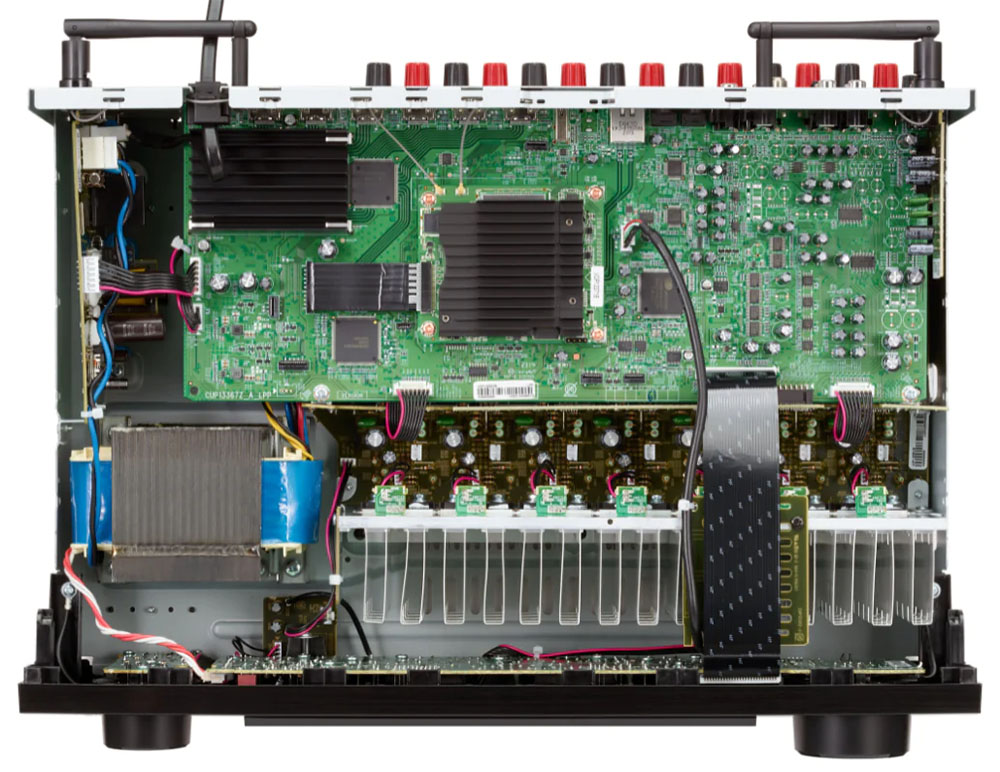
Different Genres
From rock to classical, the Denon handled various music genres with ease. Each genre was reproduced faithfully, with the receiver showcasing its versatility and ability to adapt to different sonic signatures.
The resolution of audio remained consistent across genres, with every instrument and vocal being rendered with precision and clarity. Whether it’s the dynamic energy of a rock anthem or the delicate intricacies of a classical symphony, this Denon managed to retain the essence of each genre with remarkable fidelity and detail.
Performance Conclusion
Overall, the Denon AVR-S770H delivers exceptional performance both in movies and music. With its impressive soundstage, immersive Atmos experience, and solid bass reproduction, it enhances the enjoyment of movies and music alike.
The clarity of sound, frequency reproduction, resolution of audio, and panning effects are all top-notch, providing a truly immersive and lifelike listening experience. Whether you’re watching the latest blockbuster or listening to your favorite album, this AV receiver delivers an audio experience that truly elevates your entertainment without bleeding your pocket.
Connectivity
Ports Analysis and Layout
Next we will take a look at all the connections available in the unit.
We already mentioned above about its frontal ports. These include the Headphones jack, the setup microphone port and the USB port.
At the back of the unit we find the 7 speaker terminals placed in a straight line which helps a lot with cable management. The terminals are the usual quality we have seen from Denon so all is good here, with good quality plastic caps. Keep in mind that each terminal has its own amplification.
At the top we find 6 HDMI inputs and 1 HDMI output. Three of them are HDMI 2.1 while the other three are the older HDMI 2.0.
As for the rest of the connections we get 2 optical and 1 coaxial digital inputs, 1 Ethernet port, 2 subwoofer pre-outs, 2 analogue audio inputs and one more dedicated for phono, a 2nd USB for power distribution and the usual FM/AM antenna inputs along with the WiFi/Bluetooth connectors.
Once again, as with many of these newer units, there are no composite ports available. These have been completely phased out by Denon.
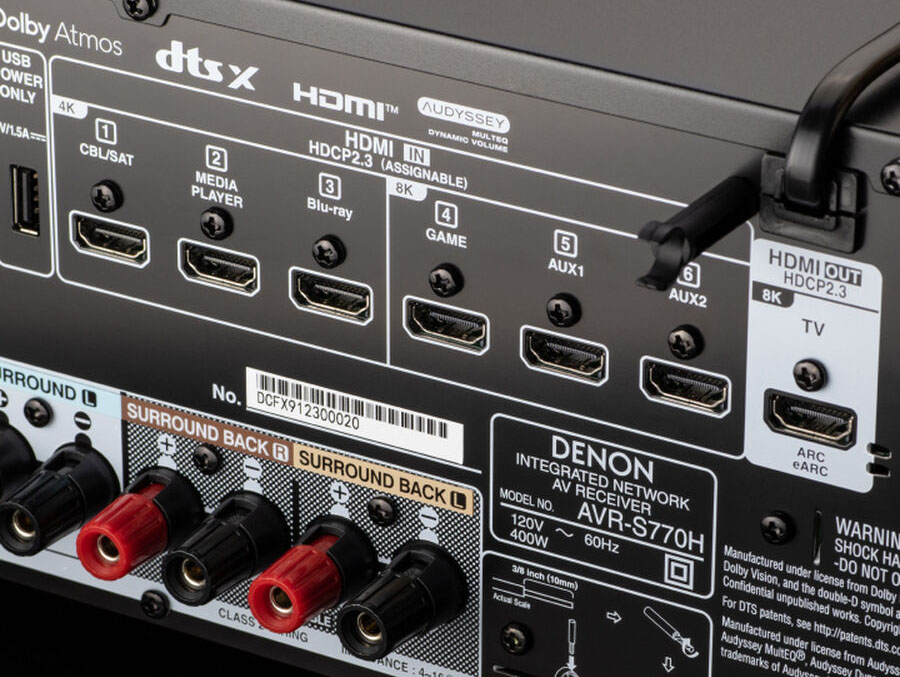
HDMI Specifications
The new AVR-S770H comes with three HDMI 2.0 ports capable of 18Gbps and three more HDMI 2.1 ports that support all the old and new exciting technologies available today.
These include 8K/60Hz and 4K/120Hz video passthrough, 40Gbps bandwidth, 4:4:4 Pure Color sub sampling, HDR10, HDR10+, Dolby Vision, Hybrid Log-Gamma (HLG), Dynamic HDR, 3D, BT.2020 pass-through, Variable Refresh Rate (VRR), Auto Low Latency Mode (ALLM) and Quick Frame Transport (QFT).
Just to make things clear the S770H is obviously using a new, bug-free HDMI 2.1 chip. All the 2020 AV receivers that featured HDMI 2.1 ports came with a bugged Panasonic chip that wouldn’t allow it to pass certain signals. Like 4K/120Hz RGB signals from the Xbox series X for example, as it would result in a black screen.
The AVR-S770H on the other hand seems to be using an updated version of this HDMI 2.1 chip which allows up to 40Gbps of bandwidth in three of its HDMI ports and this includes all the signals with a 4K@120Hz configuration including Xbox Series X.
For this review we tested both our PS5 and Xbox series X and both of them would show up a signal in 4K@120Hz. We didn’t notice any connection problems of HDMI handshaking issues. Everything was good in that front.
Wireless Capabilities
As for the unit’s wireless capabilities we get built-in WiFi (IEEE 802.11a/b/g/n/ac) which can connect both in 2.4GHz and 5 GHz networks. We also get Bluetooth v5.0 which is an update over the v4.2 that many Denon AV receivers were using till now. Unfortunately this still supports only the basic SBC codec.

OS, Apps and Features
As for extra features the AVR-S770H seems to include everything the entire S-series comes with. Let’s talk about everything in more detail.
Audio Calibration System
And we will start with the audio calibration system. Denon is using the Audyssey system. And as with all manufacturers they scale it accordingly to meet the price and performance standards of each of their models.
Audyssey MultEQ
The AVR-S770H is using the most basic version of it. The Audyssey MultEQ is a step lower than the more advanced XT version you can get in the X1800H. In comparison this one features lower resolution filters which can result in less accuracy.
The Audyssey MultEQ comes with the Dynamic Volume and Dynamic EQ features. Dynamic EQ is a feature that is responsible for keeping the clarity and dynamic levels of audio even when you like to watch at low volume, like for night viewings for example.
Dynamic Volume on the other hand is capable of balancing sudden changes and spikes in volume that could appear when there are sudden changes from TV broadcasting to commercials.

Audyssey calibration
Going through the Audyssey calibration can be done either through the built-in wizard or if you want to dive deeper into calibrating your system then you can download the Audyssey MultEQ Editor app that is available for Android or iOS and do a more thorough setup with the help of your mobile device.
The Audyssey MeultEQ Editor supports only specific AV receivers. And the AVR-S770H seems to be the lowest-tier Denon unit that does support it.
Only keep in mind that this app has a one time fee which is a shame to be honest when you already pay for the receiver. As for the built-in system, this is more than enough for most casual users as it offers almost everything you need to make very good and precise adjustments to your system.
Denon AVR Remote App
Denon provides another app for this AV receiver and this one comes completely free. The Denon AVR Remote app lets you control the unit with your mobile device through a nice visual interface.
If you don’t like the remote it comes with, this is a nice, and most important, free alternative. The app is available for both Android and iOS devices so we suggest you give it a try to see if you like it.

User Experience
And since we mentioned the visual interface we have to talk about the updated GUI that all Denon AV receivers have now. Denon changed the UI in some of their 2022 models and it seems this will be the one used for all new releases.
For some years now we were complaining about how old style and outdated the UI of the Denon AV receivers looked. It was as though it belonged in the early 2000s with its simple menus and 480p resolution.
The new menus are not all that different in terms of structure and layout. You still get the same list of features in a similar way to the old UI. But they bumped the resolution up to 1080p and made it look graphically more pleasing to the eye. Now it feels like it is something newer. And although it may not be as fancy like what smart TVs have, it is far better than what we were getting till now.
Voice Control
If you like a more hands free experience, the AV receiver supports all known voice control platforms. As such there is support for both most known ones with Amazon Alexa and Google Assistant. But there is also support for Apple’s Siri through the Airplay 2 app and the advanced automation system Josh.ai making this receiver complete in every way.
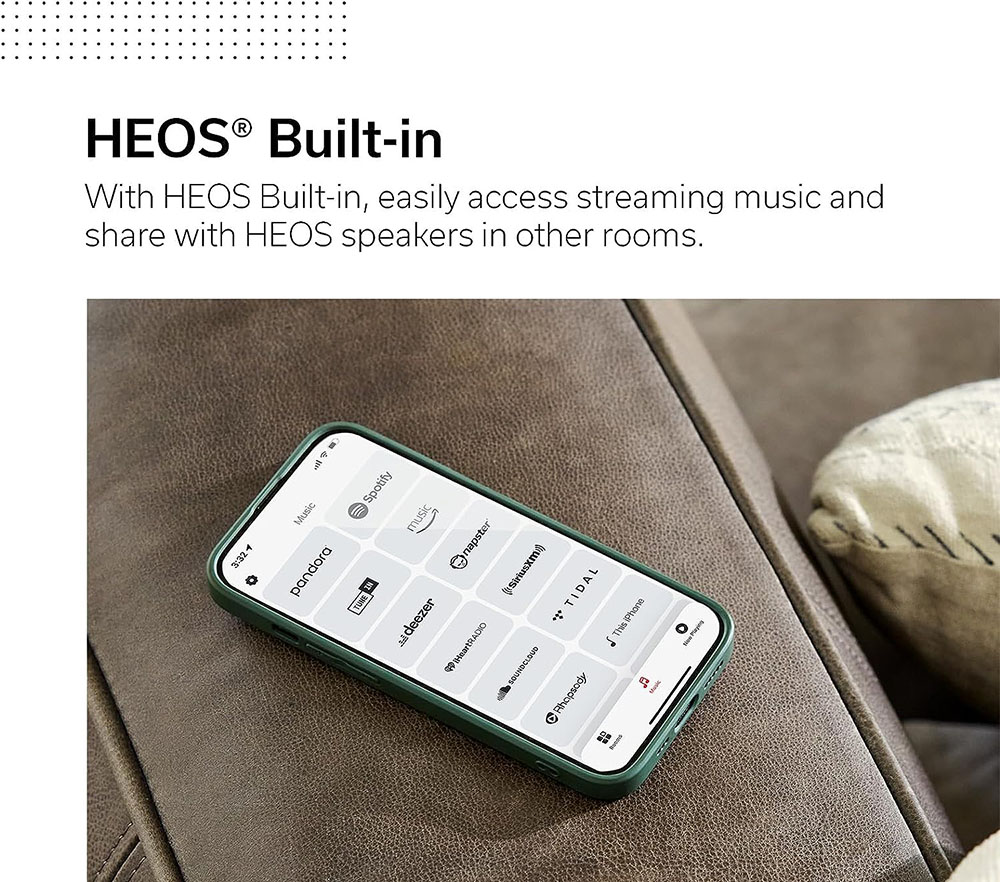
Online and Offline Streaming
For online streaming there is both HEOS and Airplay 2 you can use to stream music from one of the available online streaming services. These are TuneIn Internet Radio, Spotify, Pandora, SiriusXM and more.
As for offline streaming, there are also plenty of options for you. You can stream audio from a network drive or NAS server if it happens you to have one connected to your local network.
Also with the included frontal USB port you can stream music through some connected external storage or flash drive. Lastly if you prefer a more wireless way of streaming your music there is Bluetooth available for connecting with your mobile device. If you use Apple devices then Airplay 2 can also be used to stream music wireless through it.
Bluetooth & Speakers Output
And since we mentioned Bluetooth, another function that is included in the AVR-S770H is its ability to output sound from both the main speakers and through a Bluetooth connection. The AV receiver is capable of streaming audio to Bluetooth enabled headphones for a completely silent house experience. Or it can also output sound from both its speaker terminals and to a Bluetooth headset. This can be particularly practical in case there is a member in the family that is hearing impaired.
But keep in mind that this can be used mostly for music and not for movies. And this happens because the Bluetooth transmitter of the AV receiver is using the SBC codec and not some more advanced variant meant for such use, like aptX Low Latency. As a result there is bound to be a small audio delay due to the Bluetooth transmission speed, making this feature ideal mostly for music use.
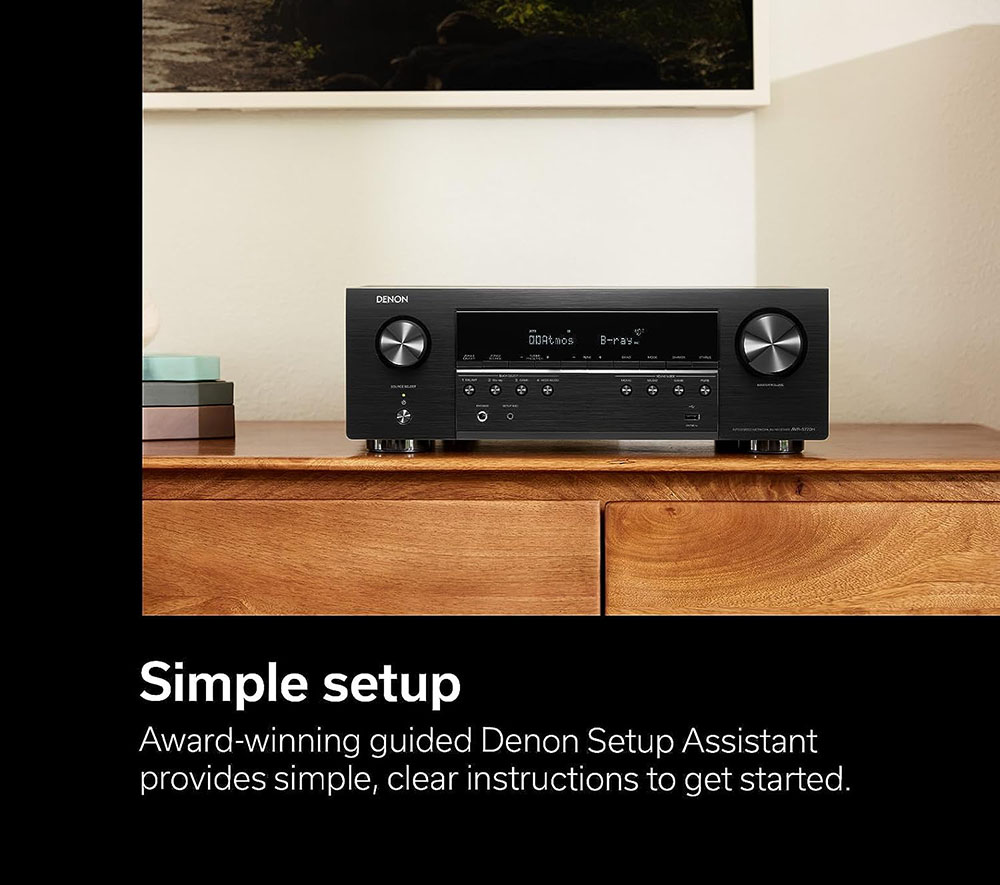
Multi-Zones Capabilities
You can also create your own multi-room environment with the use of appropriate wireless speakers. But if you prefer a wired connection the AVR-S770H also supports a Zone 2 connection through its surround back terminals available at the back of the unit.
Upscaling & ECO mode
The receiver supports video upscaling to 8K resolution. Keep in mind that there are no analog video inputs in this receiver so HDMI to HDMI upscaling is your only option.
You also get an ECO mode that can regulate the receiver’s power usage.
Roon Tested
The AVR-S770H is typically “Roon Tested” certified.
For this last one we need to clarify what this certification is. Because there are two types of certifications. Roon Ready and Roon Tested. The AVR-S770H, as with all Denon AV receivers, is Roon Tested.
This means that while Roon will work on this unit, you will not get the highest quality possible. So for example if you use Airplay, audio quality is limited to 16 Bit/44.1kHz. Keep that in mind in case Roon is specifically important to you but also want your files to be streamed in their original quality.
HDMI-CEC
There is also HDMI-CEC. This one lets you use the TV remote to control the AV receiver, if the TV also supports this. Obviously this feature lets you use only the most basic functions of the receiver but for everyday use it can be a very time saving feature. And you can reduce the amount of remotes you have to use every time.
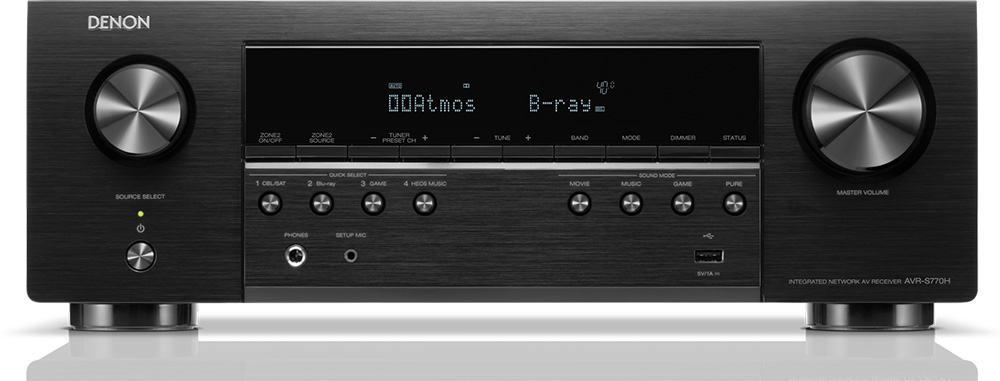
Compared to Other AV Receivers
The first obvious comparison is with this model’s predecessor, the 2021 Denon AVR-S760H. Selling at a slightly lower price at $599 the S760H’s only differences are the slightly older Bluetooth v4.2 and the inclusion of composite ports. The new AVR-S770H dropped these ports and an extra USB was added in the rear. With so few differences between them if you can get the S760H at a reduced price, its the best choice you can make.
Similar in price is the Onkyo TX-NR5100. It has many of the same features of the Denon but with two distinct differences. The Onkyo has slightly more power output but on the other hand its HDMI 2.1 ports are capped at 24Gbps bandwidth instead of the 40Gbps of the Denon.
Next on our list is the Yamaha RX-V6A. Again this is an AV receiver priced slightly lower than the Denon. In terms of specs the Yamaha has much higher power output at 100 watts but its limiting factor is its HDMI 2.1 ports. Some of the earlier RX-V6A models had the HDMI 2.1 bug and require an HDMI board change. But the HDMI 2.1 ports are also limited to just 24Gbps bandwidth which means the Denon AVR-S770H is better for gaming.
Lastly if you would like a far more affordable solution there is the Sony STR-DH790. This 7 channels AV receiver has more power at 90 watts but is missing a lot of extras. It doesn’t have HDMI 2.1 ports and there is no online functionality. If you don’t care about these then at $399 this AV receiver may be the most affordable Dolby Atmos AV receiver available.
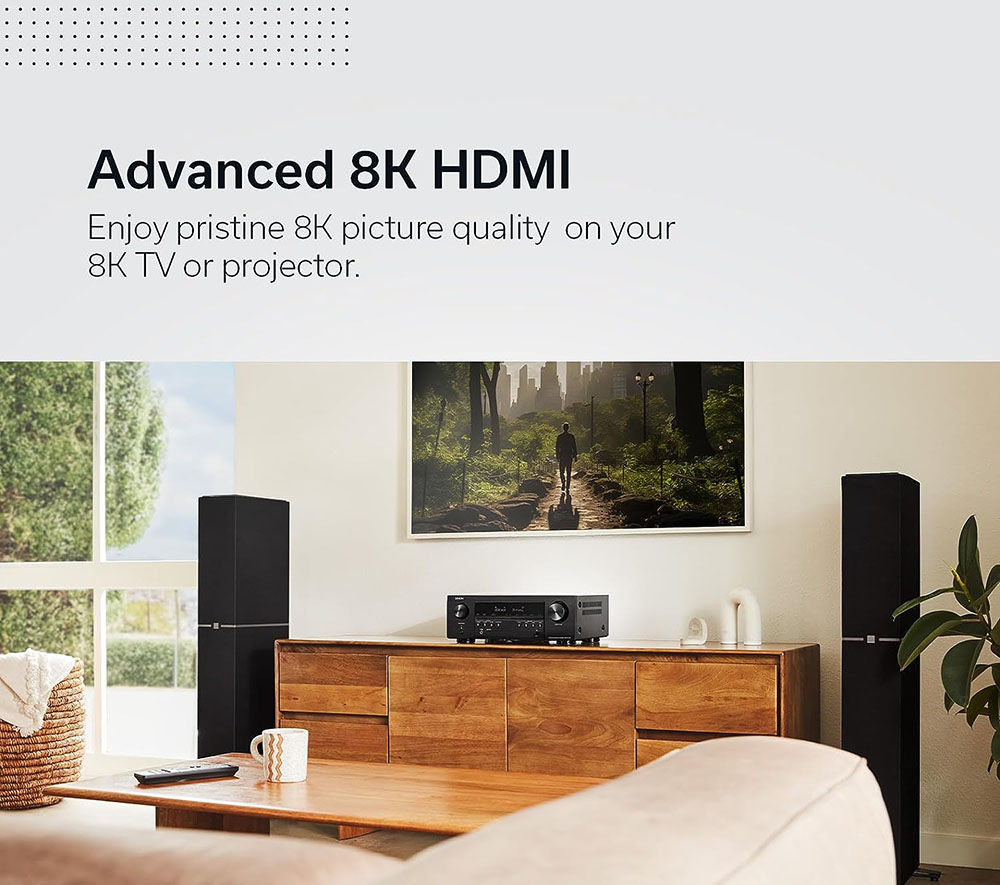
Final Thoughts
Updating older models is a good thing as brands try to keep their lineups fresh and up to date. Unfortunately this is not always the case, as many times the changes they make are minimal and as such do not require a new model. And the Denon AVR-S770H falls right into this category as the changes we found compared to its predecessor were almost non existent.
This doesn’t make this model bad. The AVR-S770H is a good performing 7.2 channels AV receiver. And the addition of Denon’s standard list of features ensures that you get plenty of online and offline functionality. Lastly its updated HDMI 2.1 ports ensure you can have a trouble free gaming experience.
On the downsides the most obvious one is basically the few differences there are with the AVR-S760H that came out 2 years ago. The new model phased out all composite ports completely and continue to have all the same problems the older one had. No front HDMI input is a frustrating one, Audyssey MultEQ Editor app is not free and missing a backlight on the remote will certainly add an extra challenge if you want to use it in a dark room.
Reaching the end of our Denon AVR-S770H review we can say that this AV receiver offers the standard experience you should expect from a Denon AV receiver in this category. The AVR-S770H holds no surprises but to be honest we were not expecting as such. For creating an affordable home theater or gaming system this one checks all the right boxes. Highly recommended.
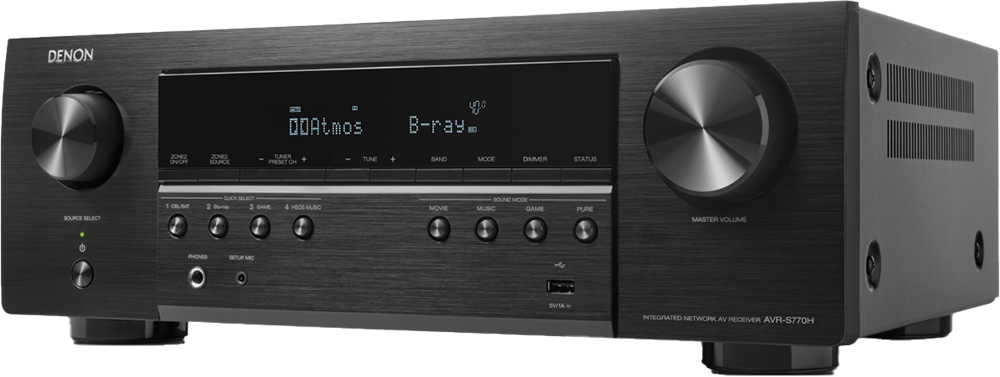
For more reviews you can check our dedicated 7 channels 8K AV Receiver reviews section or even look at our Product Reviews Table where you can find the brand and specific product you are looking for.
Cheapest Places to Buy :
*We are a reader-supported website. When you buy through links on our site, we may earn a small affiliate commission at no extra cost to you. Home Media Entertainment does not accept money for reviews.*





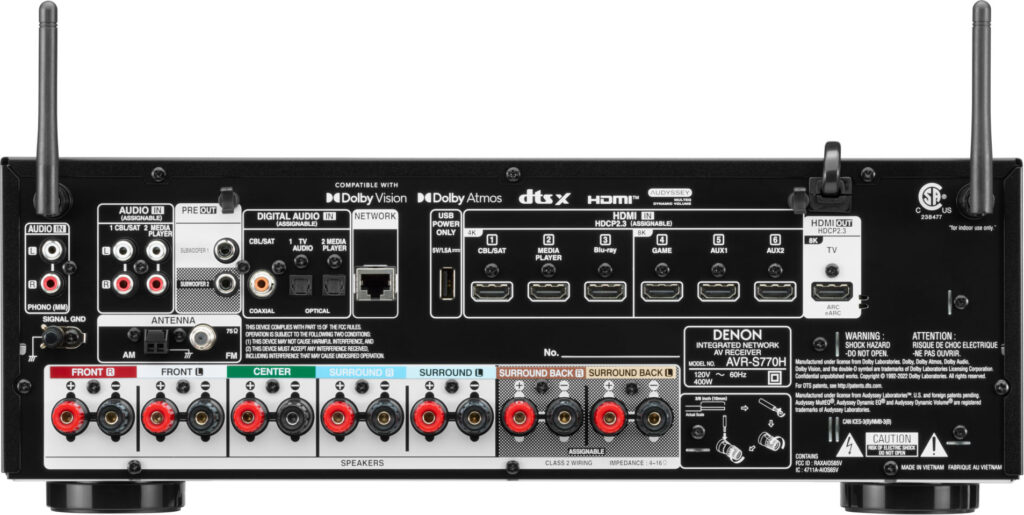
I was always fond of Denon. Had a couple of their models in the past but never any of their top tier units as I never had the money for anything expensive. But their S-series is definitely a solid one for casuals and those with low budgets. I definitely recommend this to anyone looking for a cheap model.
I agree Kyle. The S770H is definitely a good choice if you want a basic setup without going overboard with the budget. You don’t need a lot of money to create a nice Dolby Atmos system.
Hello Stratos. I see that Denon didn’t make a lot of changes compared to the S760H. Shame really. They dropped the composite ports and upped the price. What’s the point? I would go for the S760H for sure because this is plain stealing. The charge more to give you less. Is Denon naive to think that we do not see this?
Hello Eric. I wouldn’t say that Denon does not know that. But you shouldn’t think that because you are checking and comparing specs most people do the same. There is a big part of the consumer market that buy whatever they see on sale without looking any further. And Denon knows that of you can’t get the S760H you will go for the S770H no matter what. So if you know what you are looking for then I suggest buy the S760H while stock lasts.